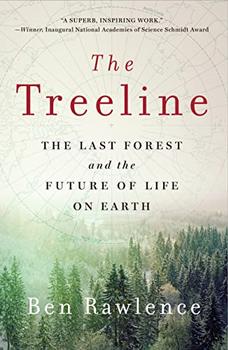Summary | Excerpt | Reviews | Beyond the Book | Readalikes | Genres & Themes | Author Bio

The Last Forest and the Future of Life on Earth
by Ben Rawlence1.
The Zombie Forest
Pinus sylvestris, Scots pine
GLEN LOYNE, SCOTLAND: 57° 04' 60' N
As the ice retreated to higher ground at the beginning of the current interglacial period, the boreal forest set off in pursuit. Plants that had not been seen on the islands of Britain for thousands of years began, gradually, to return. Ice persisted on the uplands of north Wales and the Highlands of Scotland, but in the valleys and the plains, lichens formed a crust on the exposed rocks. Then came mosses with their creeping fur, laying the ground for grasses and sedges first, soon to be followed by the pioneer shrubs of hazel, birch, willow, juniper and aspen. This boreal system worked its way north, across the land bridge where the English Channel now is, a sweeping tide of green on the heels of the ice, the cocktail of early seeds dispersed according to the natural cycles of wind, rain and the migratory patterns of animals, including humans.
Ten thousand years later, I follow. Pointing the car north from Wales, I head to where the map says the treeline has come to a halt at its present position: Scotland. Driving to Fort William through the spectacular soaring valleys along the west coast of Scotland, the rocky outcrops of the peaks appear stationary, like the roof of a cathedral merging with the sky. The rich green slopes roll back and forth with every bend in the road; scree tumbles in long runnels like waterfalls from hidden lakes of rocks high above. Sunlight shears the view, one minute blinding, the next revealing a promised land.
It is not until I am actually there that the contradiction strikes: I am searching for the upper limit of the forest, but where is the forest? Scotland's forbidding hills, rank upon rank of shadowed slopes rising out of the mist, are such a durable a sight in collective memory and culture it is almost impossible to imagine them otherwise, and yet Britain was once, briefly, an island of trees. Caledonia, as it was named by the Romans, means "wooded heights," but its "great wood" has become a mythical thing. Scotland's bare hills are both epitaph and warning: this is where the commodification of nature leads.
To ask what is happening to the treeline in such a ruined landscape is a profoundly political question. On paper, Scotland is held to be the southern and western limit of the Arctic treeline in Europe; estimates based on temperature and growing seasons suggest that here it should be at 2,300–2,400 feet.1 Stumps have been excavated at 2,600 feet dating from a slightly warmer era four thousand years ago.2 But how the treeline is responding to warming now is hard to say because nearly all the trees were cut down. Efforts to restore Scotland's great wood are under way, "re-wilding" the hills and planting trees, partly to allow them to find their level and re-establish a natural transition zone between the forest and the moor. But such changes are controversial. How we see the present and the future often depends on our understanding of the past. What is natural? What is being restored? Meanwhile, as humans debate ecological history, global warming gathers force, threatening to render our meager response irrelevant.
* * *
The treeline's first wave, or primary, vegetative cover after the last ice age resulted in a patchy forest that the foremost historian of British landscape, Oliver Rackham, calls wildwood. This was a dynamic shifting community of plants—at its southern end connected to mainland Europe by the land bridge, and at its northern frontier petering out into the moorland tundra of the "flow" country in the far north of Scotland and the scattered rocks of the Hebrides, where the dry cold of the Arctic polar vortex wrestles with the Gulf Stream for influence.
This wildwood was rampant but precarious. Birch was quick to establish but transitory, giving way to other, bigger and bolder trees. As the evolving society of the forest worked out its own logic, a steady state would emerge with a particular tree or trees dominant. In much of southern England this was lime, in the north and Wales it was a mix of hazel and oak. In the Highlands of Scotland the apex tree was originally oak. But the steady state of the wildwood could be upset and tipped into another cycle by an influx of a new species or a change in the weather. The introduction of the pine was one of these.
Excerpted from The Treeline by Ben Rawlence. Copyright © 2022 by Ben Rawlence. Excerpted by permission of St. Martin's Press. All rights reserved. No part of this excerpt may be reproduced or reprinted without permission in writing from the publisher.
There is no such thing as a moral or immoral book. Books are either well written or badly written. That is all.
Click Here to find out who said this, as well as discovering other famous literary quotes!
Your guide toexceptional books
BookBrowse seeks out and recommends the best in contemporary fiction and nonfiction—books that not only engage and entertain but also deepen our understanding of ourselves and the world around us.